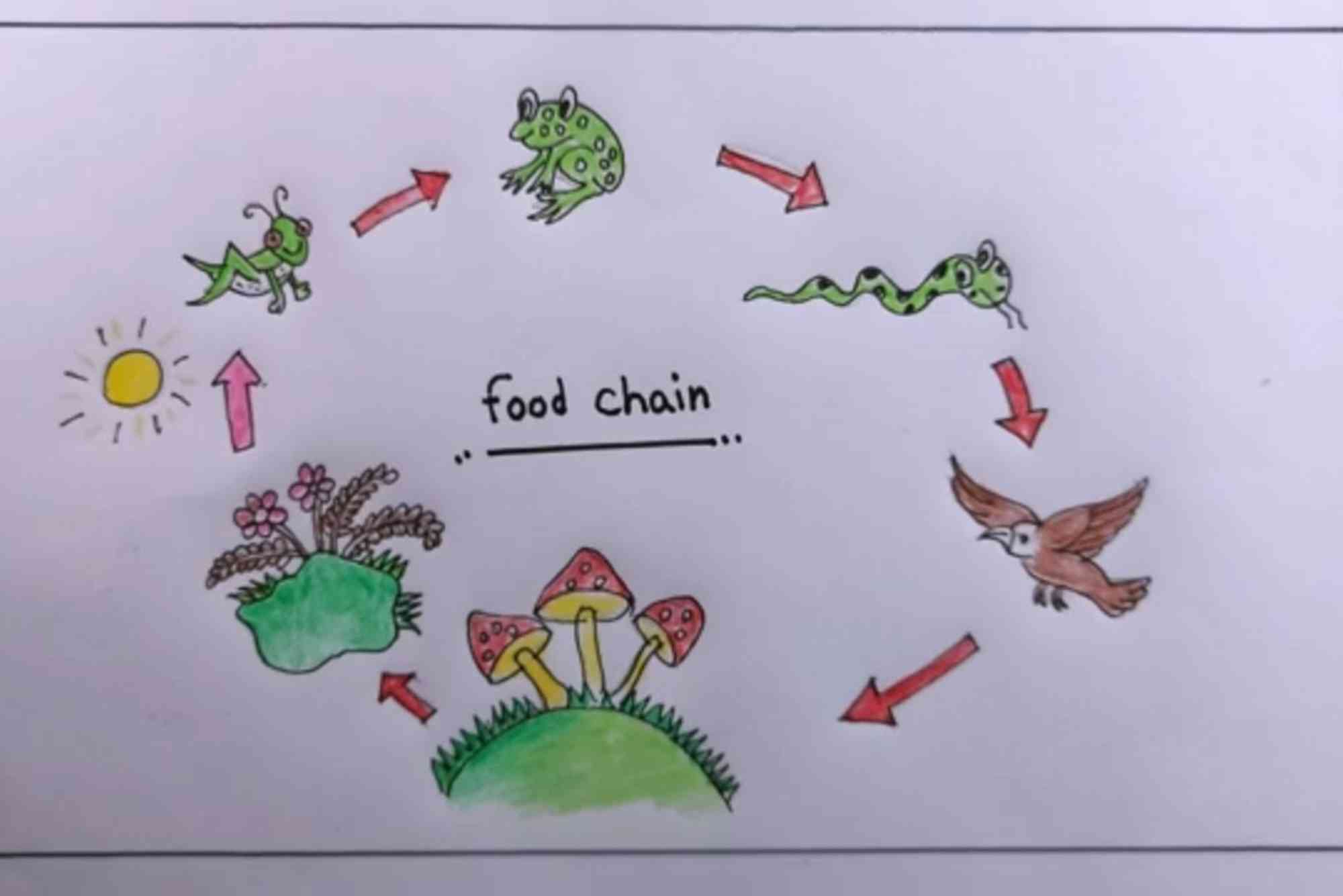Simple Food Chain Drawings for Students and Teachers
Understanding nature’s interconnectedness starts with one basic concept: the food chain. Whether you’re a student learning about ecosystems or a teacher trying to make science visual, mastering the basics of a food chain drawing is both fun and educational. From identifying producers to labeling apex predators, these drawings offer a clear representation of how energy flows in our environment. In this article, we’ll break down how to draw a food chain step-by-step, explain its components, and offer simple examples tailored for school-level projects.
What Is a Food Chain?
A food chain is a linear sequence that shows how energy and nutrients flow from one organism to another in an ecosystem. It starts with a producer (usually a green plant), followed by primary consumers (herbivores), secondary consumers (carnivores), and often ends with apex predators. Decomposers such as fungi or bacteria also play a role in breaking down dead organisms, returning nutrients to the soil.
In drawing a food chain, it’s essential to capture this order visually. Each step in the chain can be represented with simple illustrations, from sun rays shining on grass to a lion finishing the chain at the top.
Importance of Food Chain Drawings in Education
Food chain illustrations help clarify ecological concepts by simplifying complex relationships. Students often grasp ideas more quickly when they see the flow of energy as a visual representation rather than as text. Teachers use food chain drawings in classrooms, science fairs, and assignments to promote visual learning. These drawings also improve understanding of biodiversity and the balance of ecosystems.
Incorporating food chain drawing exercises into lessons helps students:
- Develop critical thinking
- Enhance observation skills
- Connect scientific theory with real-life examples
- Improve artistic expression in science education
Elements of a Good Food Chain Drawing
Creating an effective drawing begins with understanding its core components. There’s no need for advanced artistic skill—clarity is more important than complexity.
Producers
These are usually green plants or algae. They use sunlight, carbon dioxide, and water to make food through photosynthesis. In drawings, common producers include grass, shrubs, or phytoplankton.
Primary Consumers
Herbivores eat plants and serve as the next step in the chain. Illustrate animals like rabbits, deer, insects, or zooplankton depending on the ecosystem type.
Secondary Consumers
These animals eat herbivores. Include examples like snakes, frogs, or small fish.
Tertiary or Apex Consumers
Top-level predators like lions, eagles, or sharks fall here. They usually have no natural predators.
Decomposers
Bacteria, fungi, and worms break down dead matter. Though often left out, adding decomposers can make your food chain drawing more complete and ecologically accurate.
Simple Food Chain Drawing Examples
Let’s explore easy-to-draw food chain scenarios. These examples work well for school science assignments.
Grassland Ecosystem
Sun → Grass → Grasshopper → Frog → Snake → Hawk
This drawing can include clear arrows to show energy flow. Each organism can be represented with a small sketch and a label.
Ocean Ecosystem
Sun → Phytoplankton → Zooplankton → Small Fish → Bigger Fish → Shark
Colorful fish and wave illustrations help capture the ocean setting, making it ideal for younger students.
Forest Ecosystem
Sun → Tree → Deer → Tiger
A simple four-step drawing can illustrate forest ecology clearly.
Desert Ecosystem
Sun → Cactus → Insect → Lizard → Eagle
This example is perfect for showing food chains in arid environments, adding biodiversity to classroom visuals.
How to Draw a Food Chain Step-by-Step
Even beginners can follow this simple process to create a clean, understandable food chain drawing.
Choose Your Ecosystem
Select whether you want to illustrate a land, ocean, or freshwater ecosystem. Your organisms should reflect that environment.
Gather Reference Images
Look up basic pictures of each organism. You don’t have to copy them exactly—simplified versions work best.
Start with the Sun
Place a bright sun on the left corner. This reminds students that all energy in the food chain starts with sunlight.
Add Producers and Consumers
Next to the sun, draw a plant, then continue the sequence with herbivores and carnivores. Use arrows between each step to indicate energy flow.
Label Everything
Write the name of each organism under the drawing. This reinforces spelling and biological vocabulary.
Add Decomposers (Optional)
Below the chain, you can draw soil and mushrooms or worms to show the role of decomposers.
Color It In
Use colored pencils or crayons to make the illustration visually appealing. It helps younger students stay engaged.
Tips for Teachers on Using Food Chain Drawings
Teachers can maximize the learning experience by turning food chain drawing into an interactive classroom activity. Here are a few strategies:
- Let students choose different ecosystems to diversify examples
- Assign small groups to draw different levels of the food chain
- Display completed drawings on a classroom wall for ongoing reference
- Combine this activity with short research tasks for each organism
Using creative tasks makes biology lessons more memorable and ensures students understand the role of every organism.
Benefits of Food Chain Drawing for Students
Creating food chain drawings offers more than just academic insight. It supports:
- Visual memory retention
- Fine motor skill development
- Environmental awareness
- The ability to understand real-world ecosystems
When students see how energy transfers from one organism to another, they develop respect for ecological balance and nature’s complexity.
(FAQs)
Q1: What are 5 examples of a food chain?
- Grass → Rabbit → Fox
- Algae → Zooplankton → Small Fish → Tuna
- Cactus → Lizard → Snake
- Tree → Caterpillar → Bird → Hawk
- Corn → Rat → Owl
Each of these represents a simple, understandable food chain drawing ideal for educational purposes.
Q2: How do you draw a food chain diagram?
Start with the sun. Add a producer next to it, followed by one or more consumers. Draw arrows to indicate energy flow and label each organism.
Q3: Why is a food chain important?
A food chain shows how energy and nutrients move through an ecosystem. It teaches how organisms depend on each other for survival and ecosystem health.
Q4: What is the difference between a food chain and a food web?
A food chain is a linear sequence of organisms. A food web is a more complex diagram that shows many interconnecting food chains in an ecosystem.
Q5: What are decomposers, and why are they important?
Decomposers break down dead plants and animals. They return nutrients to the soil, making them essential for plant growth and ecosystem balance.
Food chain drawing is more than an artistic task—it’s a gateway to understanding life on Earth. By illustrating energy flow, students and teachers create a meaningful connection between visuals and biology. Whether you’re exploring ocean life, desert food chains, or backyard ecology, drawing brings science to life.
So next time you’re teaching or learning about ecosystems, grab a pencil and start sketching. It’s a fun, memorable way to reinforce key environmental concepts.




